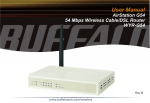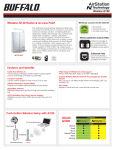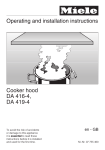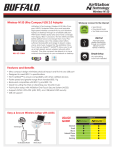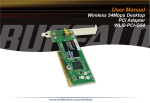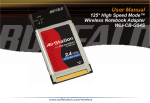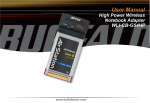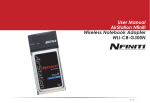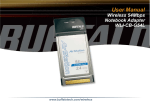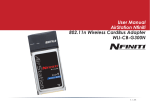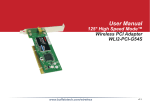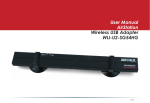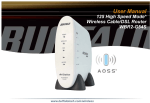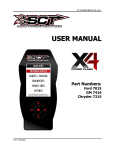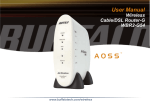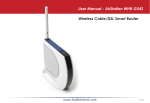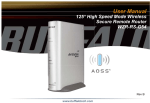Download User Manual
Transcript
User Manual AirStation G54 54 Mbps Wireless Cable/DSL Router WYR-G54 Rev B www.buffalotech.com/wireless Table of Contents Introduction . . . . . . . . . . . . . . . . . . . . . . . . . . . 05 Installation / Setup . . . . . . . . . . . . . . . . . . . . . . 11 Antenna Installation. . . . . . . . . . . . . . . . . . . . . . 13 Standard Settings . . . . . . . . . . . . . . . . . . . . . . . 14 AOSS Setup . . . . . . . . . . . . . . . . . . . . . . . . . . . 23 Advanced Setup . . . . . . . . . . . . . . . . . . . . . . . . 26 LAN Settings . . . . . . . . . . . . . . . . . . . . . . . . 26 Wireless Settings . . . . . . . . . . . . . . . . . . 26 Wireless LAN Security . . . . . . . . . . . . . . 28 LAN Port . . . . . . . . . . . . . . . . . . . . . . . . 32 DHCP Server . . . . . . . . . . . . . . . . . . . . . 33 Wireless MAC Filtering . . . . . . . . . . . . . 36 Wireless Bridge (WDS) . . . . . . . . . . . . . 38 WAN Settings . . . . . . . . . . . . . . . . . . . . . . . 40 WAN Port . . . . . . . . . . . . . . . . . . . . . . . . 40 WAN Network . . . . . . . . . . . . . . . . . . . . . 43 2 Table of Contents Network Settings. . . . . . . . . . . . . . . . . . . . . 45 Routing Setup . . . . . . . . . . . . . . . . . . . . 45 Address Translation . . . . . . . . . . . . . . . . 47 Packet Filter . . . . . . . . . . . . . . . . . . . . . . 50 Intrusion Detector . . . . . . . . . . . . . . . . . 55 UPnP . . . . . . . . . . . . . . . . . . . . . . . . . . . 57 Management . . . . . . . . . . . . . . . . . . . . . . . . 58 System Information . . . . . . . . . . . . . . . . 58 Change Password . . . . . . . . . . . . . . . . . 59 Time Setup . . . . . . . . . . . . . . . . . . . . . . 60 Traffic Information . . . . . . . . . . . . . . . . . 61 Client Monitor . . . . . . . . . . . . . . . . . . . . 62 Ping Tool . . . . . . . . . . . . . . . . . . . . . . . . 63 Log Information . . . . . . . . . . . . . . . . . . . 64 Syslog Transfer . . . . . . . . . . . . . . . . . . . 65 Save/Restore Settings . . . . . . . . . . . . . . 66 Reboot/Reload Settings . . . . . . . . . . . . . 67 Firmware Updates . . . . . . . . . . . . . . . . . 68 AOSS . . . . . . . . . . . . . . . . . . . . . . . . . . . 69 3 Table of Contents Specifications . . . . . . . . . . . . . . . . . . . . . . . . . 71 Troubleshooting . . . . . . . . . . . . . . . . . . . . . . . . 76 Glossary . . . . . . . . . . . . . . . . . . . . . . . . . . . .84 FCC Information . . . . . . . . . . . . . . . . . . . . . . . . 90 Warranty Information. . . . . . . . . . . . . . . . . . . . . 93 Contact Information . . . . . . . . . . . . . . . . . . . . . 94 4 Introduction AirStation G54 Wireless Cable/DSL Router (WYR-G54) This manual introduces you to the AirStation Cable/DSL Router, and will help you connect to your network quickly. The WYR-G54 router, is a wireless 4-port router network device that complies with the 2.4GHz IEEE 802.11g standard specification on wireless LANs. It also supports various advanced router technologies. The WYR-G54 supports enhanced built-in NAT/SPI firewall functions and is used as a multi-functional router/link between wired and wireless LAN computers. Summary of the AirStation WYR-G54 features: • Support for wireless security encryption using TKIP and WEP. • DHCP client/server function. • VPN pass-through, for secure communications using IPSec or PPTP. • Packet Filtering for eliminating unwanted communication types. • SOHO/SMB routing and firewall functions provide a safer private networking environment, including support for MS NetMeeting and MSN-Messenger. • Additional SPI Firewall Functions - DMZ, intrusion detection and notification • Supports Universal Plug and Play (UPnP). • Enhanced security features: - SPI Firewall and DMZ zone functions to prevent unknown intruders. - Intrusion Detector Firewall (NAT) 5 Introduction - Dynamic packet filtering. - Wireless encryption via TKIP and WEP. - VPN pass-through for IPSec and PPTP connections. - Packet monitoring and filtering by MAC address, IP address and port. - PPPoE support • Buffalo’s easy web interface configuration • Broadband router static and dynamic routing methods between WAN and LAN based on updated routing tables. An economical way to bridge multiple networks. • Web based setup wizards for both Cable and DSL broadband connections. Home Networking 1 Buffalo AirStation wireless access points enable sharing broadband by simply connecting the AirStation to a DSL or Cable modem to: • Share files and printers • Access and share the Internet • Share media files SOHO/SMB Networking With high-speed DSL or Cable connections readily available, many users can work effectively from a home office, connected securely to a corporate network. Buffalo’s solutions are ideal for home 6 Introduction networks that require secure, high-speed access to the corporate LAN. Tools that play an integral part in Buffalo’s solutions include VPN connectivity for secure access to corporate resources, which enable the remote employee to handle information from clients or coworkers as if they were in the office. Connect the Buffalo AirStation Broadband router AP to a Cable or DSL modem in order to: •Share broadband access •Share files and printers •Bridge between multiple networks and multiple computer platforms •Provide easy and secure access to home or company networks from remote locations System Requirements • Broadband (High-Speed) Internet connection or existing Local area connection • Any Wi-Fi (wireless) compatible computer with a Web Browser Internet Explorer or Netscape 4.5 or later. (Safari 1.0 is supported with Macintosh OS X.2) AirStation WYR-G54 Package Contents The AirStation WYR-G54 package consists of the following items. 1. WYR-G54 Base Station 2. AC adapter/power cable 3. CAT5 LAN cable 4. Utility CD with Manual 7 Introduction 5. Quick Setup Guide 6. Warranty Statement Product Views Power - Lit when the device is powered on. Wireless - Lit when the wireless radio is on. Flashes when wireless traffic is present. WAN - Lit when connection to Cable/DSL modem is present. Flashes when internet traffic is present. Status - Flashes red when performing diagnostic functions or when an error exists. Link/Act - Indicates an active link between the corresponding LAN port and another network device. 100 - Lit orange when the corresponding LAN port is communicating at 100 Mbps (otherwise 10 Mbps). 8 Introduction About the AirStation CD The AirStation does not require any software to be installed on your computer for configuration. The AirStation CD contains client drivers for Buffalo Wireless Adapters (i.e. Notebook Adapter and Desktop PCI Adapter) and the AirStation documentation. Prior to copying or installing any software, please read the Software License Agreement “license. 9 Introduction txt”, located in the root folder of the CD. By installing, copying or using the AirStation software, you are consenting to the terms of this agreement. If you do not agree to all of the terms of the Software License Agreement, do not download, copy or install the AirStation software. It is the policy of Buffalo Technology to improve products as new technology, components, software and firmware become available. Please consult the AirStation wireless website (http://www.buffalotech.com/wireless) to download and install the latest firmware for your product. Follow these simple steps to connect the AirStation to your Broadband Internet connection allowing you to combine and share wired and wireless computers and printers with the high-speed internet connection. 1. Power down the Cable or DSL modem and the computer which will be used to configure the 10 Installation / Setup AirStation router. 2. Plug the Cable or DSL’s LAN Ethernet cable into the AirStation’s WAN port. Initially, you may need to unplug this cable from your computer, hub or other router. 3. Plug the provided Ethernet cable into a LAN port on the AirStation and plug the other end into your computer Ethernet adapter’s (NIC) port. If you plan to initially configure the AirStation via a wireless connection, (not recommended), you may skip this step. 4. Power on your cable or DSL modem, wait one full minute, Power on the AirStation router, wait another full minute and then power on the computer which will be used to configure the AirStation. If the red DIAG light on the AirStation is lit or flashing after several minutes of being powered on, please consult Buffalo Technical Support. Introduction Configuring the AirStation using a standard web browser requires basic wireless configuration knowledge. Setup includes manual wireless configuration and basic administrative management. Setup Preparation Make note of the AirStation’s wired MAC address found on the rear of the AirStation. It is also recommended you record any other broadband ISP information such as global IP address, subnet mask address, default gateway address, DNS server address and PPPoE parameters. Setup Overview 11 Installation / Setup Buffalo recommends using a wired connection, meaning your computer is physically connected to the AirStation with a CAT5 straight cable plugged into one of the four LAN ports This type of setup will eliminate possible setup problems due to any issues with the wireless adapter on the computer being used to configure the AirStation. A Web browser version 4.5 or later can be used to configure the AirStation. Advanced settings for security, filtering and other features will be explained in later sections. Open the Setup Screen • Connect the WYR-G54 according to the wiring instructions in Section 2. • The WYR-G54 has a default LAN IP address of 192.168.11.1 and Subnet Mask of 255.255.255.0. ■ Note: The computer used to configure the AirStation should be set to obtain an IP address automatically using a DHCP server. The Quick Setup Guide enclosed with the product contains detailed instructions on how to configure your computer for initial configuration. On the computer used to configure the AirStation, launch a Web Browser 4.5 or later. - Enter 192.168.11.1 into the URL field. - A window will open prompting you to enter a User ID and Password. 12 Antenna The WYR-G54 has one internal omnidirectional antenna. The transmission of wireless signals is isotropic, meaning that the waves are emitted much like the sun distributes light in every direction. However, connection problems can occasionally be remedied by simply adjusting the position of the antenna. External antennas come in all shapes and sizes. Antennas also come with different connectors. The WHR2-G54 has an ‘MC Connector’ on it. Thus, the antenna must also have an MC connector. To install the antenna, slide the antenna connector door on the back of the WYR-G54 to the right. This will expose the MC Connector. Attaching the antenna is simple, just insert the antenna’s MC Connector into the WYR-G54’s MC Connector and firmly push it in until it snaps into place. Once snapped, the antenna’s connector will swivel with ease. It is important not to push the antenna connector in at an angle. To remove the antenna, pull the antenna connector out. It is important not to pull the antenna connector out at an angle. 13 Logging In Enter “root” as the User ID and leave the password field blank. ■ Note: These are the factory default settings 14 Setup Wizard - Launch Internet Setup Initial Settings Screen • Click the Internet Setup arrow button to begin the Internet Setup Wizard. • Advanced users have the option of skipping this step and begin manually configuring the access point. Choosing a Connection Type Choosing a Connection Type Click on the type of broadband connection your ISP is providing. Note: If you are unsure of whether you are using cable or DSL broadband, please contact your ISP. DSL users can now skip to Page 18! 15 Setup Wizard - Setup Cable Connection Options Cable Connection Options - Choose the type of connection configuration as provided by your ISP - Most Cable operators provide the first type of configuration - Automatic (DHCP) Automatic IP Assignment by ISP DSL PPPoE Settings Screen - Select ‘Automatic IP Assignment by ISP’ if your ISP’s DHCP server assigns an IP address automatically. 16 Setup Wizard - Cable Manual Entry of IP Information Manual IP Address Settings - If your IP Information is provided by your ISP, fields are provided to fill in the information. - Some ISPs also require that a certain MAC Address is used. If this is not specifically required, just use the default MAC Address. Automatic IP Address Settings with Manually Entered DNS Settings The IP Address is Acquired Automatically but DNS Server Address is Entered Manually - If the ISP provides your IP configuration automatically, but requires manual entry of DNS information, fields will be provided for DNS information after an IP Address is successfully acquired. Cable Users can now skip to Page 19! 17 Setup Wizard - DSL DSL Connection Options DSL Connection Options - Choose the type of connection configuration as provided by your ISP - Most DSL operators provide the first type of configuration - Automatic (DHCP) - When using a LAN connection type of DSL, network settings are automatically delivered by your ISP. PPPoE Setup DSL PPPoE Settings Screen - Enter the requested information into the fields provided. Note that DNS information is only required to complete setup if specifically required by the ISP. 18 Setup Wizard - Line Test Line Test Line Test Once the Setup Wizard is complete a line test to the Internet will launch to verify successful entry of settings. If the connection fails, please verify the accuracy of the entered information with the ISP. If the Line Test is successful, the AirStation is now finished with basic setup and client devices should be able to connect to the Internet through the AirStation. The next step involves setting up wireless security, which is optional. 19 Setup Wizard - Security Wireless Security Setup Security Setup Encrypting your wireless data is important to prevent other devices from being able to monitor your wireless data transmissions. There are two options available TKIP or WEP. One or the other may be selected, or you can choose not to enable security and allow open movement of traffic. TKIP - check with your client adapter vendors to make sure that ALL of your wireless adapters support this method of WPA encryption. WEP - while most wireless adapters support WEP, it has been shown not to be as robust as TKIP, though it is considered adequate for home use. Disabled - when security is disabled, clicking Continue will return you to the Home screen where other configurations can be made or you can Log Out of the access point and begin using your AirStation normally. 20 Wireless Settings Security Setup Completion WEP Setup TKIP Setup - If WEP is chosen as the encryption type, you need only to enter in an encryption key. Note that depending on the type (ASCII vs. HEX), the length of the key will vary depending on the numbers of bits in use. - If TKIP is chosen as the encryption type, you need only to enter a pre-shared key. Note that depending on the type (ASCII vs. HEX), the limitations of the key length will vary. The rekey interval can be left at its default settings unless advanced configuration is needed. 21 - Once the encryption key has been successfully added, the AirStation will save the key and restart. At this point, the key will need to be entered into any device connecting wirelessly to pass data through the AirStation. If problems are encountered connecting wirelessly with the encryption key, please use a wired connection to attempt configuration or reset the AirStation with its reset button on the rear face. Wireless Settings LAN Settings LAN Settings Click on the LAN Settings button within the left frame to configure basic or advanced LAN settings. Wireless Settings Wireless Mode - Allows you to choose between supported rate sets. - Mixed - supports both 11b and 11g clients (default setting) - Turbo - supports only 11g clients. 11b clients will not be allowed to associate, thus improving overal performance of the wireless network. - Legacy - only 11b rates are supported. Use this for troubleshooting older wireless adapters. 22 23 Wireless Settings SSID - Allows administrator to alter the SSID of the AirStation. To communicate with a specific AP only, the AP’s SSID must be entered in the client computer. The client computer looks for the specific AP (or SSID) for wireless communication. Use up to 32 alphanumeric characters for the SSID (case sensitive). By default the SSID is the LAN Mac address of the AirStation. ■ Note: Roaming - When multiple AirStations have an identical SSID, WEP key (if WEP is used), (and channel in WDS mode) , client computers may Roam between the AirStations. Wireless Settings Wireless Channel - Select the channel used for wireless communication. There are 11 overlapping channels. Channels 1, 6 and 11 are non-overlapping. The ‘Auto-Channel’ option is recommended, as it constantly assesses the best available channel for the AirStation to operate on. If there are multiple APs in close proximity using the same channel, there may be interference. In this case, change to a non-overlapping channel. Broadcast SSID - Enable or Disable the SSID (SSID) from being broadcasted. If denied, the 24 Wireless Settings AirStation will not be found unless the specific AirStation’s SSID is entered in the client computer manually. Wireless Radio Enabled - By default the wireless radio is turned on, however by disabling the radio, no wireless communications can take place. Wired connections can continue uneffected though. Access to LAN - Specific clients can be given access to the local network (LAN) by enabling this limitation. By default all clients (wired and wireless) have access to the local network resources. Local network resources can include but are not limited to, other computers’ shared files, networked printers and scanners. Access to WAN - Specific clients can be given access to the Internet (WAN) by enabling this limitation. By default all clients (wired and wireless) have access to the Internet through the WAN port. To add users to the access tables, they must have previously connected to the AirStation. Select the clients you wish to limit access to and click Apply. Choosing Clients that can Access LAN or WAN Resources Clients can be removed from the table at a later time if needed. Note: Always click Apply to save your changed settings to the AirStation. 25 Wireless Security Wireless Security Setup Encrypting your wireless data is important to prevent other devices from being able to monitor your wireless data transmissions. Security Setup There are two options available TKIP or WEP. One or the other may be selected, or you can choose not to enable security and allow open movement of traffic. TKIP - check with your client adapter vendors to make sure that ALL of your wireless adapters support this method of WPA encryption. WEP - while most wireless adapters support WEP, it has been shown not to be as robust as TKIP, though it is considered adequate for home use. Disabled - when security is disabled, clicking Continue will return you to the Home screen where other configurations can be made or you can Log Out of the access point and begin using your AirStation normally. 26 Wireless Security Security Setup Completion WEP Setup TKIP Setup - If WEP is chosen as the encryption type, you need only to enter in an encryption key. Note that depending on the type (ASCII vs. HEX), the length of the key will vary depending on the numbers of bits in use. - If TKIP is chosen as the encryption type, you need only to enter a pre-shared key. Note that depending on the type (ASCII vs. HEX), the limitations of the key length will vary. The rekey interval can be left at its default settings unless advanced configuration is needed. 27 - Once the encryption key has been successfully added, the AirStation will save the key and restart. At this point, the key will need to be entered into any device connecting wirelessly to pass data through the AirStation. If problems are encountered connecting wirelessly with the encryption key, please use a wired connection to attempt configuration or reset the AirStation with its reset button on the rear face. Advanced Settings WAN Port Settings WAN Port Settings WAN MAC Address - The WAN Ports MAC Address occassionaly is required to be set to a value other than the default. Only change the value if required by your ISP. Login Method - There are several ways of creating a connection to your broadband provider. In most cases, your ISP will use a Direct Connection, however, in some cases PPPoE or IP Unnumbered is used which will require the entering of information provided by your ISP. If you are unsure of which to use, please contact your ISP. 28 Advanced Settings Direct Connection Options - IP Address and DNS Server Address settings may have been provided by your ISP. If this is the case, they should be entered here, otherwise leave the default settings in place to acquire these settings automatically via DHCP. Direct Connection Options 29 PPPoE Client Options PPPoE Client Options - If you are using PPPoE for your broadband connection, your ISP should have given some custom information to enter. If you do not have this information, it will be necessary to collect it from them. PPPoE Client Options The connection can be set to the following types: Connection on Demand - The connection is opened when activity is detected and terminated after a set period of inactivity (20 minutes by default). Manual Connection - The connection must be manually started and stopped. Continuous Connection - The AirStation will keep the connection alive indefinitely. PPPoE Multisession - The AirStation supports PPPoE Multisession as well. If your class of broadband requires this information, hit the Multisession to enter the information in a separate window. Make sure to hit Apply when the data entry is complete. The MTU value (578-1492) should only be changed if specifically instructed to by your ISP. 30 Advanced Settings Remote Management - When enabled, remote management will allow you to configure your access point remotely over the Internet. A port should be specified between the ranges of 1 and 65535. WAN Network Settings The management interface can then be accessed by your IP Address as shown and the port as in http://244.244.222.130:10500 where 244.244.222.130 is the WAN IP Address and 10500 is the specified port. Reply to Ping from WAN Port - When the AirStation is set to respond to Ping requests, it will acknowledge its IP Address and various other information from over the Internet. This is useful to managing remote access points and ensuring uptime, but it can be considered a security breach as well as it does distribute some minimal information about your router. At the minimum, make sure you have changed your root (administrator) password with either of these functions enabled. 31 Dyanmic DNS Dynamic DNS is useful to allow your AirStation to respond to requests for a domain name such as www.yourname.com or mail.yourname.com. Dynamic DNS Due to the fact that many ISPs use DHCP rather than fixed IP Addresses, hosting services like web servers, game servers, FTP servers or mail servers can be very challenging. DDNS provides a solution. Entry ways for several third party services are included on your access point. While each has been prescreened for compatibility and customer service, Buffalo Technology USA can not provide adquate technical support for these services. For complete support and setup procedures, please visit the website of the service of your choosing. 32 Routing Information RIPv1 Routing - RIP dyanmic routing allows routing information to be shared with out ther routers using RIPv1 routing. This will allow easy sharing of information between multiple routers in regards to their own resources or stored entries within their routing tables. This improves the overall performance within a complex set of separate networks. Routing Information Static Routes - Static routes can be added to the routing table to facilitate routing amongst devices. By entering the necessary IP Information about a property and a metric to specify the required number of hops between routers to reach a device, the most efficient path can be calculated among multiple routers. The values entered for the IP Address, Subnet Mask and Gateway should be the IP information of the remote network device that is being routed to by the AirStation. 33 Address Translation Address Translation (NAT) Address Translation Bridging PPPoE and VPN Pass-Through PPPoE Bridging - If a device on the LAN Ports is capable of managing PPPoE client communications, enabling this option will allow the device the necessary direct, pass-through access to the WAN port. VPN Pass-Through - If you have client devices that will need to create VPN tunnels with IPSec or PPTP, this option should not be disabled. It is enabled by default. 34 Address Translation In some situations, it is benDemilitarized eficial to have a client network Zone Client device designated as a catchall, with all ports opened to enable better functionality with services like messaging or gaming. Using a Demilitarized zone will allow one local network device to be exposed to the Internet for use of a specialpurpose service such as Internet gaming or videoconferencing. DMZ hosting forwards all the ports at the same time to the selected device. Packet Filtering is more secure as it only opens the ports designated to be opened, while a Demiliatrarized Zone will open every port of a designated device. 35 Network Address Translation NAT by Service and Device Address Translation by Service Some of the common services that address translation is necessary to use with are offered preconfigured. By selecting a service, most fields will be autofilled to make setup easier, however if you are using a service different from what is offered or with different configurations, you can a a new service by clicking the Add New Server button. Be sure to accurately enter the appropriate settings and clicking the appropriate network device from the Local Client Server dropdown list while it is connected to the AirStation. 36 Packet Filtering The AirStation supports the TCP and UDP protocols for Network Address Translation. Packet Filtering Packet Filtering Packet Filtering configures advanced public services on your local network, such as web servers, FTP servers, email servers, gaming servers or other specialized Internet services that require delivery of specific requests through the router to the appropriate local network device for delivering specific appication requests. When unique requests for a particular response are delivered to your router via the Internet, the router will forward those requests to the designated local network device for appropriate response. Because when DHCP is in use, IP Addresses could change for a client device over time, it is best practice to assign local network devices that have packet filtering rules assigned to them to use a fixed IP Address to prevent failures due to a change in IP Address that the packet filter does not acknowledge. 37 Advanced Settings Intrusion Detector Intrusion Detector There are three levels for Intrusion Detector to function at. High: Recommended for Internet bandwidth of 2 Mbps or higher. Medium: Recommended for Internet bandwidth between 1 and 2 Mbps bandwidth. Low: Recommended for bandwidth under 1 Mbps. Because your AirStation uses an SPI Firewall, it is important to temper your security level to your broadband connection speed. Even at the Low setting, your AirStation will provide an ample amount of security for your network. 38 UPnP UPnP Service UPnP Service Enabling the UPnP Service enables other UPnP enable devices to easily regonize and configure one another according to the developing UPnP standard. Note: If IP-Unnumbered configuration is in use for DSL connections, UPnP should not be enabled to prevent conflicts. 39 System Information System Information System Information Firmware Version - Displays the current firmware version running on the AirStation. DHCP - Displays whether the AirStation is operating as a DHCP client on its WAN port. The amount of time left on the DHCP lease is shown as well as the ability to have the AirStation release and renew its current IP configuration on the WAN port. LAN/WAN -Various details about the IP configuration and MAC Addressing information is shown about the LAN and WAN ports. The connection method of the WAN port and the status of that connection is displayed as well. 40 Basic Settings Basic Settings Basic Settings The AirStation is configured with an administrator account named root. It can not be changed to another name. The default password of the AirStation is blank (i.e. no text). This value can and should be changed. The new password should be 8 alphanumeric characters long and can include an underscore character ( _ ). The password is case sensitive. If the password is forgotten, it will be necessary to reset the AirStation via the Reset button on the rear face, which will cause all other configurations to restore to factory defaults. 41 Advanced Settings Client Monitor Client Monitor Client Monitor allows you to view the currently connected clients. While DHCP clients are shown automatically, it is necessary to manually add clients with fixed IP Addresses in order for them to appear in Client Monitor By clicking Detailed PC Settings a new window will appear where you can manually fix what IP Address is assigned to DHCP clients. This is useful for managing multiple DHCP clients that will have the same IP Address at each connection. 42 Diagnostics Diagnostics The Diagnostics screen allows you to perform some basic connectivity troubleshooting. A local or external IP Address can be entered and checked for connectivity by clicking Ping. Diagnostics The results from the Ping will show whether external or internal connectivity is present to a client device or remote resource from the router. This is useful to confirm that a connectivity problem exists on a client rather than on the router. Also, to check name resolution via DNS, a domain name can be entered. The results will show the IP Address of the domain name if successful. A failure could indicate an error in the DNS Server entries for the router that should be confirmed with your ISP. 43 Log Information Log Information Log You can specify the types of events Information that are recorded into the log for later viewing. Internet Connection - Logs successes for failures when connecting externally via the WAN port. Access Restrictions - Logs successes or failures of clients connecting via the LAN port. Intrustion Detector - Logs possible malicious attacks that are blocked by the Intrusion Detector firewall Note: To add value to the recorded logs, be sure to set your time zone accurately. 44 Save or Restore Settings Save or Restore Settings Save Settings - Your current settings can be saved as an image file that can be restored to your AirStation at a later date. This is also useful for easily setting up multiple AirStations with identical settings. Restore Settings - If a settings file was previously created, it can be quickly restored to the AirStation. Note that the settings file will overwrite all current settings when it is restored. 45 Restore Defaults Restart Restart or Restore Settings Occasionally it may be necessary to restart your AirStation. Often the first start in troubleshooting a problem is to simply restart the device. Restore Factory Defaults To return the AirStation back to its original out of the box configuration, click the Restore button. All changes will be lost, so it is best practice to create a saved settings file in advance. 46 Advanced Settings Buffalo Technology USA regularly provides firmware updates to enhance performance, provide additional features and to fix bugs. Please check our website listed below for udpates. Firmware updates should be done with a wired connection as opposed to wirelessly. Also, it is best practice to save your current settings to a saved settings file in advance. Please review the release notes to see if a firmware update is necessary. Your current update version can be found in the System Information section of your management screen. Use of firmware outside of the geographic region that the AirStation is being used in may be a violation of your country or state laws. To update your firmware download the image from our website. Then unzip the package if necessary to a known location on your computer. Click the Browse button and point it at the image file. Then click Update to proceed. The AirStation will restart after the process is complete and normal operation should resume. Firmware updates can be found for the USA and Canada only at: http://www.buffalotech.com/support/downloads.php 47 Troubleshooting Common Problems: • Out of range, client cannot connect to the AirStation. • Configuration mismatch, client cannot connect to the AirStation. • Absence or conflict with the Client Driver. • Conflict of another device with the AirStation hardware. Status LED Lit Red Unplug the power for three seconds. Plug the power back in to monitor the DIAG LEDs during start-up. If any symptoms match section B.1.1, call the Buffalo Tech Support line 24 hours a day, 7 days a week at 866-752-6210 or email [email protected] for USA and Canada only. Table B.1.1 DIAG LED Activity Table DIAG LED Display Time Description/Action Continuous Red Starting RAM Error Red flash, 2 times Starting Flash ROM Error Red flash, 3 times Starting A problem on the wired LAN side Red flash, 4 times Starting A problem on the wireless LAN side B. 1.2 LEDs Work But Client PC Cannot Connect to Network 48 Troubleshooting If the LEDs indicate that the network is working properly (Power LED is on, Transmit/Receive LED blinks), check the TCP/IP settings of the network. Changing Client TCP/IP Settings in Windows Consult the LAN Administrator for TCP/IP settings. To add or change the TCP/IP Settings: 1. On the Windows task bar click Start. 2. Select Settings, then Control Panel. 3. Double-click on the Network icon to view the Network Properties. 4. From the list of installed components, verify the TCP/IP => wireless LAN adapter protocol is installed. • If the wireless adapter protocol is not yet installed, click the Add button and select the TCP/IP protocol from the list. Refer to Windows Help for more information. • If the wireless adapter protocol is installed, select the protocol and click the Properties button. Verify the parameters match the settings provided by your LAN Administrator. Make changes if necessary, and click OK. 5. When or if prompted, restart your computer. B. 1.3 Other Problems Please refer to www.buffalotech.com for further reference materials. 49 Glossary 10BaseT or 100BaseTx: 802.3 based Ethernet network that uses UTP (Unshielded twisted pair) cable and a star topology. 10 is 10 Mbps and 100 is 100 Mbps. Cross-Over Wiring: A UTP cable that has its transmit and receive pair crossed to allow communications between two devices. 802.1x: The standard for wireless LAN authentication used between an AP and a client. 802.1x with EAP will initiate key handling. Ad-Hoc Network: The wireless network based on a peer-to-peer communications session. Also referred to as AdHoc. DCE (Data Communications Equipment): Hardware used for communication with a Data Terminal Equipment (DTE) device. Default Gateway: The IP Address of either the nearest router or server for the LAN. Default Parameter: Parameter set by the manufacturer. Bandwidth: The transmission capacity of a computer or a communication channel, stated in Megabits per second (Mbps). Destination Address: The address portion of a packet that identifies the intended recipient station. BSS (Basic Service Set): An 802.11 networking framework that includes an Access Point. DHCP (Dynamic Host Configuration Protocol): Based on BOOTP, it uses a pool of IP addresses, which it assigns to each device connected to it, and retrieves the address when the device becomes dormant for a period of time. Bus Mastering: A system in which the specified Input/Output device (e.g. NIC Card) can perform tasks without the intervention of the CPU. DNS (Domain Name System): System used to map readable machine names into IP addresses Client: A PC or workstation on a network. 50 Glossary Driver: Software that interfaces a computer with a specific hardware device. Ethernet cable: A wire similar to telephone cable that carries signals between Ethernet devices. DSSS (Direct Sequence Spread Spectrum): Method of spreading a wireless signal into wide frequency bandwidth. File and Print Sharing: A Microsoft application that allows computers on a network to share files and printers. DTE (Data Terminal Equipment): Device that con10BaseT or 100BaseTx: 802.3 based Ethernet network that uses UTP (Unshielded twisted pair) cable and a star topology. 10 is 10 Mbps and 100 is 100 Mbps. Firmware: Programming inserted into programmable read-only memory, thus becoming a permanent part of a computing device. Frame: A fixed block of data, transmitted as a single entity. Also referred to as packet. Dynamic IP Address: An IP address that is automatically assigned to a client station in a TCP/IP network, typically by a DHCP server. Full-Duplex: To transmit on the same channel in both directions simultaneously. ESS (Extended Service Set): A set of two or more BSSs that form a single sub-network. SSID is user identification used in the ESS LAN configuration. Half-duplex: To transmit on the same channel in both directions, one direction at a time. Hub: A device which allows connection of computers and other devices to form a LAN. Ethernet: The most widely used architecture for Local Area Networks (LANs). It is a sharedmedia network architecture. The IEEE 802.3 standard details its functionality. IEEE (Institute of Electrical and Electronics Engineers): The professional organization which promotes development of electronics technology. 51 Glossary IP (Internet Protocol) Address: A unique 32binary-digit number that identifies each sender or receiver of information sent in packets. Mbps (Mega Bits Per Second): A measurement of millions of bits per second. MDI/X (Media Dependent Interface/Crossover): Port on a network hub or switch that crosses the incoming transmit lines with the outgoing receive lines. Infrastructure: A wireless network or other small network in which the wireless network devices are made a part of the network through the Access Point. MHz (MegaHertz): One million cycles per second. ISP (Internet Service Provider): A company that provides access to the Internet and other related services. IV (Initialization Vector): The header section of an encrypted message packet. NAT (Network Address Translation): An internet standard that enables a LAN to use one set of IP addresses for internal traffic and a second set for external traffic. LAN (Local Area Network): A group of computers and peripheral devices connected to share resources. NIC (Network Interface Card): An expansion card connected to a computer so the computer can be connected to a network. LED (Light Emitting Diode): The lights on a hardware device representing the activity through the ports. Packet: A block of data that is transferred as a single unit, also called a frame or a block. Packet Filtering: Discarding unwanted network traffic based on its originating address or its type. MAC (Medium Access Control) Address: A unique number that distinguishes network cards. 52 Glossary PCI (Peripheral Component Interconnect): A bus that is connected directly to the CPU. mation between computers. RADIUS (Remote Authentication Dial In User Service): A server that issues authentication key to clients. PCMCIA (Personal Computer Memory Card International Association) Card: Removable module that adds features to a portable computer. RAM (Random Access Memory): Non-permanent memory. Ping (Packet Internet Groper): An Internet utility used to determine whether a particular IP address is online. Repeater Hub: A device that collects, strengthens and transmits information to all connected devices, allowing the network to be extended to accommodate additional workstations. Plug and Play: Hardware that, once installed (“plugged in”), can immediately be used (“played”), as opposed to hardware that requires manual configuration. RC4: The encryption algorithm that is used in WEP. RJ-45 connector: An 8-pin connector used between a twisted pair cable and a data transmission device. PoE (Power over Ethernet): A mechanism to send DC power to a device using a CAT5 Ethernet cable. ROM (Read Only Memory): Permanent memory. Router: Device that can connect individual LANs and remote sites to a server. PPPoE (Point-to-Point Protocol over Ethernet): A specification for connecting users on an Ethernet line to the Internet through a common broadband medium. Roaming: The ability to use a wireless device while moving from one access point to another without losing the connection. Protocol: A standard way of exchanging infor53 Glossary Script: A macro or batch file containing instructions and used by a computer to perform a task. TCP/IP (Transmission Control Protocol/Internet Protocol: Protocol used by computers when communicating across the Internet or Intranet. Server: Any computer that makes files or peripheral devices available to users of the network and has a resident Network OS. TKIP (Temporal Key Integrity Protocol): An encryption method replacing WEP. TKIP uses random IV and frequent key exchanges. SMTP (Simple Mail Transfer Protocol): The protocol used to define and deliver electronic mail (E-mail) from one location to another. Topology: The shape of a LAN (Local Area Network) or other communications system. SNMP (Simple Network Management Protocol: An application layer protocol that outlines the formal structure for communication among network devices. Twisted Pair: Cable that comprises 2 or more pair of insulated wires twisted together. UDP (User Datagram Protocol): A communication method (protocol) that offers a limited amount of service when messages are exchanged between computers in a network. UDP is used as an alternative to TCP/IP. Static IP Address: A permanent IP address is assigned to a node in a TCP/IP network. Also known as global IP. STP (Shielded Twisted Pair): Twisted Pair cable wrapped in a metal sheath to provide extra protection from external interfering signals. Uplink: Link to the next level up in a communication hierarchy. Subnet Mask: An eight-byte address divided into 4 parts separated by periods. UTP (Unshielded Twisted Pair) cable: Two or more unshielded wires twisted together to form a cable. 54 Glossary WAN (Wide Area Network): A networking system covering a wide geographical area. WEP (Wired Equivalent Privacy): An encryption method based on 64 or 128-bit algorithm. Web Browser: A software program that allows viewing of web pages. Wi-Fi (Wireless Fidelity): An organization that tests and assures interoperability among WLAN devices. Wire Speed: The maximum speed at which a given packet can be transferred using Ethernet and Fast Ethernet standard specifications. WLAN (Wireless LAN): A LAN topology using wireless devices. VPN (Virtual Private Network): A security method to connect remote LAN users to a corporate LAN system. 55 FCC / CE Information Federal Communication Commission Interference Statement This equipment has been tested and found to comply with the limits for a Class B digital device, pursuant to Part 15 of the FCC Rules. These limits are designed to provide reasonable protection against harmful interference in a residential installation. This equipment generates, uses and can radiate radio frequency energy and, if not installed and used in accordance with the instructions, may cause harmful interference to radio communications. However, there is no guarantee that interference will not occur in a particular installation. If this equipment does cause harmful interference to radio or television reception, which can be determined by turning the equipment off and on, the user is encouraged to try to correct the interference by one of the following measures: • Reorient or relocate the receiving antenna. • Increase the separation between the equipment and receiver. • Connect the equipment into an outlet on a circuit different from that to which the receiver is connected. • Consult the dealer or an experienced radio/TV technician for help. FCC Caution: To assure continued compliance, (example - use only shielded interface cables when connecting to computer or peripheral devices). Any changes or modifications not expressly approved by the party responsible for compliance could void the user’s authority to operate this equipment. This device complies with Part 15 of the FCC Rules. Operation is subject to the following two conditions: (1) This device may not cause harmful interference, and (2) this device must accept any interference received, including interference that may cause undesired operation. 56 FCC / CE Information IMPORTANT NOTE: Federal Communication Commission Interference Statement This equipment has been tested and found to comply with the limits for a Class B digital device, pursuant to Part 15 of the FCC Rules. These limits are designed to provide reasonable protection against harmful interference in a residential installation. This equipment generates, uses and can radiate radio frequency energy and, if not installed and used in accordance with the instructions, may cause harmful interference to radio communications. However, there is no guarantee that interference will not occur in a particular installation. If this equipment does cause harmful interference to radio or television reception, which can be determined by turning the equipment off and on, the user is encouraged to try to correct the interference by one of the following measures: -Reorient or relocate the receiving antenna. -Increase the separation between the equipment and receiver. -Connect the equipment into an outlet on a circuit different from that to which the receiver is connected. -Consult the dealer or an experienced radio/TV technician for help. This device complies with Part 15 of the FCC Rules. Operation is subject to the following two conditions: (1) This device may not cause harmful interference, and (2) this device must accept any interference received, including interference that may cause undesired operation. FCC Caution: Any changes or modifications not expressly approved by the party responsible for compliance could void the user’s authority to operate this equipment. 57 FCC / CE Information FCC RF Radiation Exposure Statement: This equipment complies with FCC radiation exposure limits set forth for an uncontrolled environment. This equipment should be installed and operated with minimum distance 20cm between the radiator & your body. This transmitter must not be co-located or operating in conjunction with any other antenna or transmitter. BUFFALO declared that WYR-G54 is limited in CH1~11 by specified firmware controlled in USA. Safety This equipment is designed with the utmost care for the safety of those who install and use it. However, special attention must be paid to the dangers of electric shock and static electricity when working with electrical equipment. All guidelines of this manual and of the computer manufacturer must therefore be allowed at all times to ensure the safe use of the equipment. EU Countries intended for use The ETSI version of this device is intended for home and office use in Austria, Belgium, Denmark, Finland, France (with Frequency channel restrictions), Germany, Greece, Iceland, Ireland, Italy, Luxembourg, Norway, The Netherlands, Portugal, Spain, Sweden, Switzerland and United Kingdom. The ETSI version of this device is also authorized for use in EFTA member states Iceland, Liechtenstein, Norway and Switzerland. EU Countries Not intended for use None. Potential restrictive use France: Only channels 10,11,12, and 13. 58 Warranty Information Buffalo Technology (Melco Inc.) products comes with a two-year limited warranty from the date of purchase. Buffalo Technology (Melco Inc.) warrants to the original purchaser the product; good operating condition for the warranty period. This warranty does not include non-Buffalo Technology (Melco Inc.) installed components. If the Buffalo product malfunctions during the warranty period, Buffalo Technology/(Melco Inc.) will, replace the unit, provided the unit has not been subjected to misuse, abuse, or non-Buffalo Technology/(Melco Inc.) authorized alteration, modifications or repair. All expressed and implied warranties for the Buffalo Technology (Melco Inc) product line including, but not limited to, the warranties of merchantability and fitness of a particular purpose are limited in duration to the above period. Under no circumstances shall Buffalo Technology/(Melco Inc.) be liable in any way to the user for damages, including any lost profits, lost savings or other incidental or consequential damages arising out of the use of, or inability to use the Buffalo products. In no event shall Buffalo Technology/(Melco Inc.) liability exceed the price paid for the product from direct, indirect, special, incidental, or consequential damages resulting from the use of the product, its accompanying software, or its documentation. Buffalo Technology/(Melco Inc.) does not offer refunds for any product. @ 2004 Buffalo Technology (Melco, Inc.) 59 Contact Information ADDRESS Buffalo Technology (USA), Inc. 4030 West Braker Lane, Suite 120 Austin, TX 78759-5319 GENERAL INQUIRIES Monday through Friday 8:30am-5:30pm CST Direct: 512-794-8533 | Toll-free: 800-456-9799 | Fax: 512-794-8520 | Email: sales@buffalotech. com TECHNICAL SUPPORT North American Technical Support by phone is available 24 hours a day, 7 days a week. (USA and Canada). Toll-free: (866) 752-6210 | Email: [email protected] * When operating in High-Speed Mode, this Wi-Fi device achieves an actual throughput of up to 34.1 Mbps, which is the equivalent throughput of a system following 802.11g protocol and operating at a signaling rate of 125 Mbps. 60 4030 W. Braker Ln. Suite 120 Austin, Texas 78759 Tel: 800-456-9799 Fax: 512-794-8606 Technical Support is available 24 hours a day, 7 days a week (USA / Canada) Toll-Free: 866-752-6210 email: [email protected] ©2004, Buffalo Technology (USA), Inc. 61





























































